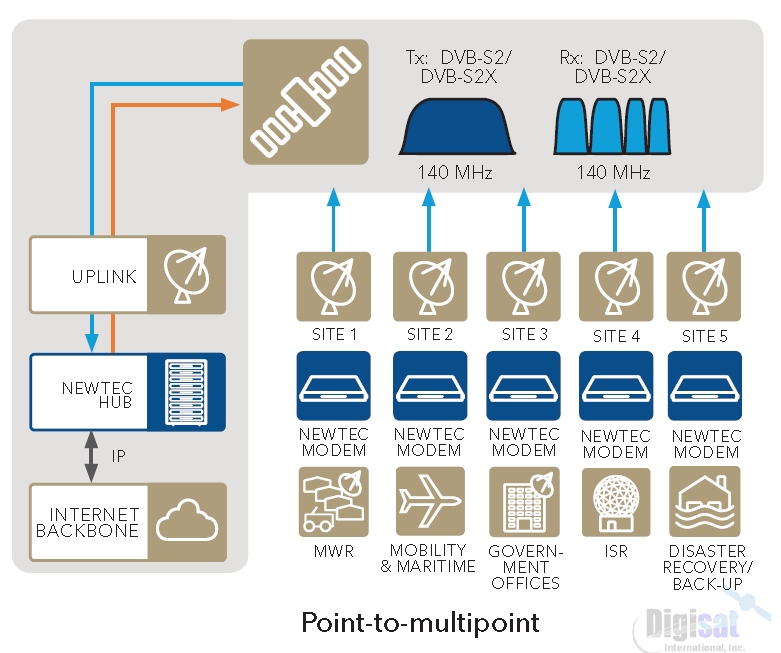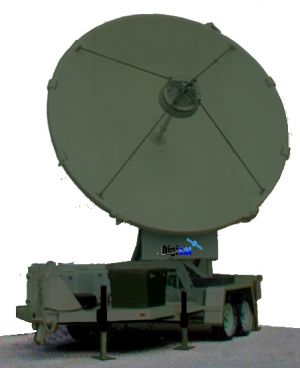Newtec Satcom WGS Satellite Modem MDM9000
WGS certified, baudrates up to 133 Mbaud, DVB-S2 and DVB-S2X (QPSK upto 256APSK), reduced impact of RF Interference (RFI) by enabling the optional DVB RF Carrier ID (DVB-CID)
MDM9000 WGS Satellite Modem
The Newtec Satcom WGS certified MDM9000 Satellite Modem is completely optimized for a massive range of mobile and fixed government and defense applications over satellite. It’s typically installed at both ends of a point-to-point satellite link or at the remote sites of a star network.
The unit can act as a modulator, demodulator or modem depending on the network configuration and integrates seamlessly with terrestrial networks and equipment. The modem is in full compliance with the DVB-S2 and the recently released DVB-S2X standards while being backward compatible with Newtec S2 Extensions mode, all in order to achieve barrier-breaking efficiency at maximum service availability. In receiver mode, the MDM9000 serves as demodulator with dedicated intelligence gathering features.

RF Efficiency at the core
The 9000 series satellite modem combines a number of innovative elements to improve current market available efficiencies, thereby lowering the overall Total Cost of Ownership. New modulation and Forward Error Correction (FEC) codes up to 256APSK in the DVB-S2X standard in combination with innovative technologies such as 133 Mbaud, Clean Channel Technology, Bandwidth Cancellation (BWC), Automatic Uplink Power Control (AUPC), FlexACM, QoS, and Equalink 3 are embedded in the modem and bring the satellite link to full efficiency. The performance can be increased even more by adding Newtec’s network optimization technologies such as acceleration, compression, shaping and bandwidth management. By increasing the amount of data that can be transferred per transponder this modem caters for data and video hungry applications such as ISR, MWR, data backhaul, strategical links and disaster recovery networks.
Advanced Reliability
Newtec’s auto-adaptive technology FlexACM is incorporated in the modem by default and deals with fading conditions (rain, dust, interference) and inclined orbit satellites with varying throughput. Thanks to FlexACM these fading conditions will no longer interrupt the transmission between the hub and remote sites nor result in loss of data. The
maximum possible throughput can be achieved at all times.
Additionally the Automatic Uplink Power Control mechanism can ensure maximum use of the linkbudget at all times. In case of link loss due to full shadowing effects, the quick reacquisition feature inside the modem will reactivate the transmission in milliseconds after the satellite link becomes available again.
Point to Multipoint Network Configuration Diagram

Input Interfaces
• Auto switching 10/100/1000 Base-T Ethernet interfaces
• GSE Encap/Decap performance
Imix (avg 340 byte)
TX only: 300 Mbps
RX only: 360 Mbps
RX + TX: 523 Mbps
Max PPS (46 byte)
TX only: 120 kpps
RX only: 150 kpps
RX + TX: 220 kpps
• Maximum Data Rate
425 Mbps simplex, 850 Mbps duplex
• Layer 2 bridge function: Ethernet over satellite (IPv6/VLAN/MPLS compatible)
• Layer 3 static router function: IPv4 packets over satellite
• Supports Jumbo frames (9216 bytes)
• Up to 100 routes
• Advanced QoS features
Adaptive Traffic Shaping on bitrate or symbolrate according to PIR/CIR
Flexible traffic classification on VLAN/MPLS/ IPv4/IPv6
• GSE, MPE, XPE or ULE Encapsulation/ Decapsulation of IP/Ethernet frames in DVB-S2, DVB-S2X and S2 Extensions
• Data filtering (downlink):
Up to 64 receive filters
Modulation and Demodulation
SUPPORTED MODULATION SCHEMES AND FEC
• DVB-S2 (acc. ETSI EN 302 307 v1.2.1 for DVB-S2)
Outer/Inner FEC: BCH/LDPC
52 MODCODs (short & normal frames):
QPSK: from 1/4 to 9/10
8PSK: from 3/5 to 9/10
16APSK: from 2/3 to 9/10
32APSK: from 3/4 to 9/10
• Newtec S2 Extensions
Outer/Inner FEC: BCH/LDPC
54 MODCODs:
QPSK: from 45/180 to 144/180
8PSK: from 80/180 to 150/180
16APSK: from 80/180 to 162/180
32APSK: from 100/180 to 162/180
64APSK: from 90/180 to 162/180
29 Linear MODCODs:
8PSK-L: from 80/180 to 120/180
16APSK-L: from 80/180 to 162/180
64APSK-L: from 90/180 to 162/180
• DVB-S2X standard
Outer/Inner FEC: BCH/LDPC
53 MODCODs (normal frames):
QPSK: from 1/4 to 9/10
8PSK: from 3/5 to 9/10
16APSK: from 26/45 to 9/10
32APSK: from 32/45 to 9/10
64APSK: from 11/15 to 5/6
128APSK: 3/4; 7/9
256APSK: 32/45; 3/4
13 Linear MODCODs (normal frames):
8APSK-L: 5/9; 26/45
16APSK-L: from 1/2 to 2/3
32APSK-L: 2/3
64APSK-L: 32/45
256APSK-L: from 29/45 to 11/15
41 MODCODs (short frames):
QPSK: from 11/45 to 8/9
8PSK: from 7/15 to 8/9
16APSK: from 7/15 to 8/9
32APSK: from 2/3 to 8/9
• FlexACM controller (optional)
• FlexACM client (optional)
• Automatic Uplink Power Control
BAUD RATE RANGE
• SCPC use: 0.256 Mbaud – 133 Mbaud
• BWC use: 0.256 Mbaud – 72 Mbaud
FRAME LENGTH
• Short frames of 16200 bits for DVB-S2 and DVB-S2X
• Normal frames of 64800 bits for DVB-S2, DVB-S2X and Newtec’s S2 Extensions
CLEAN CHANNEL TECHNOLOGY
• Roll-off: 5% -10% -15% -20% - 25% - 35%
EQUALINK 3
• Linear pre-distortion
• Non-linear pre-distortion for all MODCODs
CARRIER INTERFERENCE REDUCTION
• DVB RF Carrier ID
(CID according ETSI TS 103 129 v1.1.1)
• Spread Spectrum Modulator (BPSK)
• Supports User Data
• Compliant to DVB Standard
BANDWIDTH CANCELLATION (BWC)
• Max symbolrate: 72 Mbaud
• Delay range 0 to 500 ms
• Cancellation range: -10 to +10 dB local to remote carrier
• Cancellation ratio: > 30 dB
• Es/No degradation (dB) at 0 dB
cancellation ratio
- QPSK : 0.1 dB
- 8PSK: 0.2 dB
- 16APSK: 0.4 dB
- 32APSK: 0.6 dB
- 64APSK: 1.0 dB
- 128APSK: 1.2 dB
- 256APSK: 1.5 dB
• Monitoring: delay, frequency offset, local/ remote power, local/total power, phase noise
• Fractional license for redundant modem
Modulation Interfaces
L-BAND
• Connector N(F), 50 Ohm (optional SMA adapter)
• Frequency 950 - 2150 MHz (10 Hz steps)
• Level -35/+7 dBm (+/- 2 dB)
• Return loss > 14 dB
• Switchable 10 MHz Reference
• Spurious performance
Better than - 65 dBc/4kHz @ +5 dBm output level and > 256 kBaud
Non-signal related: < - 80 dBc @ +5 dBm output
IF-BAND
• Connector BNC (F) - 75 Ohm
(intermateable with 50 Ohm)
• Frequency 50 - 180 MHz (10 Hz steps)
• Level -35/+10 dBm (± 2 dB)
• Return loss 50 Ohm : > 14 dB
75 Ohm : > 20 dB
• Spurious performance
Better than - 65 dBc/4 kHz @ +5 dBm output level and > 256 kBaud
Non-signal related:< - 80 dBc @ +5 dBm output
L-BAND MONITORING
• Connector SMA (F), 50 Ohm
• Frequency Same as L-Band output frequency or 1050 MHz in case of IF output option only
• Level -45 dBm
• Return loss > 10 dB
10 MHZ REFERENCE OUTPUT (OPTIONAL)
• Connector BNC (F), 50 Ohm
• Output level +3 dBm (+/- 2dB)
BUC POWER (OPTIONAL)
• Max. current: 3.8 A
• Voltage: 24 V, 48 V (Software controlled)
Demodulation Interfaces
DUAL L-BAND INPUT
• Connector 2 x F-type (F), 75 Ohm
• Return loss > 7 dB (75 Ohm – F(F))
• Maximum total input power: - 10 dBm
• Maximum input signal power: (-30 + 10log(f))dBm where f=baud rate in Mbaud
• Minimum input signal power: (-80+Es/ No(thr)+10log(f))dBm where f=baud rate in Mbaud and Es/No(thr)= Es/No value in dB for QEF reception
• Frequency 950 - 2150 MHz
• Adjacent signal < (Co+7) dBm/Hz with
Co = signal level density
IF-BAND INPUT
• Connector BNC (F) - 75 Ohm
• Return loss > 15 dB
• Level See L-band input level spec above + 10dBm
• Frequency 50 - 180 MHz
• Adjacent signal < (Co+7) dBm/Hz with
Co = signal level density
LNB POWER AND CONTROL
• Max. current 350 mA (on selected IFL input)
• DiSEqC control
Internal 10 MHz Reference Frequency
STANDARD STABILITY
• Stability: +/- 2000 ppb over 0 to 70° C
• Ageing: +/- 1000 ppb/year
VERY HIGH STABILITY (OPTIONAL)
• Stability: +/- 2 ppb over 0 to 65°C
• Ageing: +/- 500 ppb/10 year
Generic
MONITOR AND CONTROL INTERFACES
• M&C connectivity via separate Ethernet links
• Web server GUI (HTTP) via web browser
• Diagnostics report, alarm log (HTTP)
• SNMP v2c
• Modified OpenAMIP protocol to control stabilized antenna from modem
ALARM INTERFACE
• Electrical dual contact closure alarm contacts
• Connector 9-pin sub-D (F)
• Logical interface and general device alarm
Physical
• Height 1RU, width: 19”, depth 51 cm, 5.8 kg
• Power supply:
90-130 & 180-260 Vac, 125 VA, 47-63 Hz
or 36-76 VDC, 160 W
• Temperature:
Operational: 0°C to +50°C /+32°F to +122°F
Storage: -40° to +70°C /-40°F to +158°F
• Humidity: 5% to 85% non-condensing
• CE label and UL
Allows service providers and government operations to increase the amount of services or the customer base within the same bandwidth. At the same time it introduces ways to reduce OPEX costs and increase the profitability of your operations at maximum efficiency and optimum availability.




